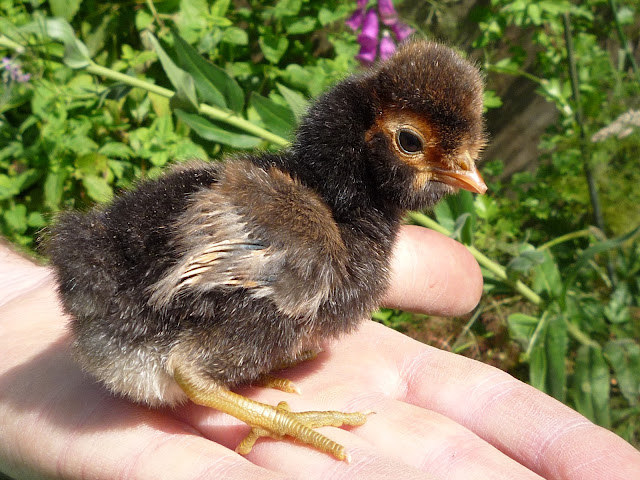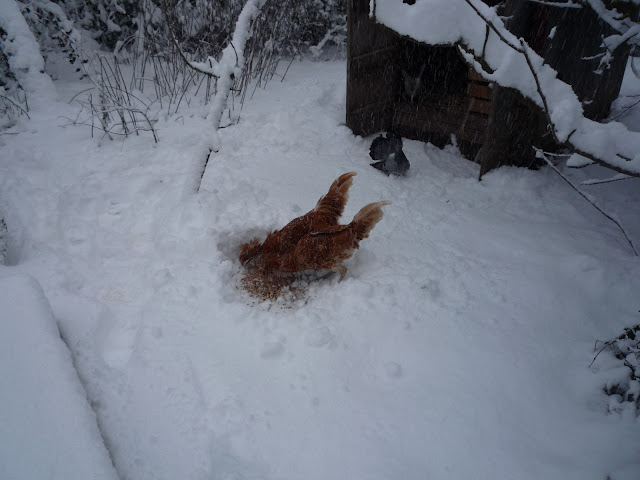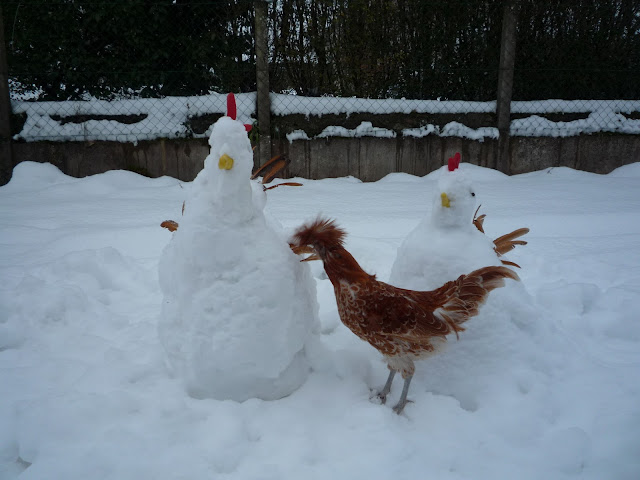Here is Garbo getting ready for a treatment. It is best to do this in the evening, if possible and where it is warm and peaceful. This will put your bird in a relaxed state, so that she or he will be much more receptive to being treated. Using an essential oil, which has a pleasant and calming scent also helps! You can find Part 1 of this article on identification of poultry lice here
A few words on essential oils
In a following blog I am going to share in more detail the essential oils I use and the infused oils I make. I have been treating with them for many years, having first provided myself with a good 'textbook' and had numerous conversations with local organic farmers. In fact the oil I am using in this treatment was one recommended by the latter.
N.B. Except for Lavender essential oil and in a case of severe infection, Tea Tree, I would never use a pure essential oil upon a bird. Oils should be diluted in a suitable organic carrier oil, such as olive, sunflower or coconut. The ratio I use is one teaspoon (5ml) of carrier oil per bird to 1-3 drops of oil. However, when I am treating a lot of birds at once I usually use no more than 10 drops at any one time in a large pipette bottle (100ml) of carrier oil. In the case of a very powerful oil, such as essential oil of oregano, I would not use more than 3 drops in total for the flock. These are the rules I apply to my own birds and I have found that they work.
Eucalyptus citriodora and how it works on lice.
All the lemon scented essential oils have the effect of disrupting the olfactory receptors, so the parasite can not easily find its host. Furthermore, when you apply any sort of viscous carrier oil to a louse, the spiracles, pores through which it breathes, become blocked and thus its air supply is cut off. You might therefore ask why bother with the essential oil. Well, I have read that in laboratory tests on lice, an hour after being blocked with oil, the spiracles begin to clear and the louse actually revives! Therefore, as a back up procedure we add the essential oil, eucalyptus citriodora, which has the properties of an insecticide. In using this essential oil you thus have the double effect of killing the ectoparasite and discouraging any others, who escape, from coming back.
How, when and where to apply
Because I have been using essential oils for a long time I find it easy to apply them straight from the pipette bottle. These, by the way, you should be able to purchase from your local chemist or on-line. However, if you are worried about the bird moving and spilling it or getting it on sensitive areas, then you might feel happier using a cotton bud dipped in the oil.
First check the obvious areas, remember you are looking both for the lice and their eggs (nits). You do not want to put too much oil on the bird, apart from being limited to how much essential oil you should use, you do not want to saturate the down feathers and risk chilling the bird. On the first treatment I would check all the key areas where the lice congregate. These are mainly those where it is difficult for the bird to reach and groom. Therefore, around the vent, along the spine, under the top of the wing, in the depression at the back of the neck above the wing, on the breast and if they have one, on the crest. Strangely enough I rarely find lice on my Polish birds' crests, you would think it would be a great hiding place but it is also possibly one area really obvious for other birds to notice and groom.
Assess, which areas have the highest concentration of lice and in particular nits and treat them first. You can leave other areas until the next day. Already you will be getting rid of the greater proportion of parasites and making the bird feel better. You want the bird to remember a positive outcome, rather than for it to feel uncomfortable because you have kept it too long under a possibly stressful treatment. Keep assessing the bird as you treat, if it starts to kick or make worried noises then stop and take a break. Everything you do now will impact on how easy it will be to treat in the future
Lice move really fast once you expose them to light, so get yourself organised and ready to treat as soon as you move the feathers aside. Having a bird who is co-operative is a real bonus. If you are treating a bird for the first time he or she is obviously going to be a bit concerned as to what you are doing. They will also see the pipette as threatening and possibly try to peck or bite it. Given also the sensitivity of the areas you are treating just be aware of how they will be feeling, so having birds that are tame and who already know and trust you is really a prerequisite of a successful and stress-less experience. If you are not in this position with your birds then having someone to help you hold the bird and keep it calm may be a good idea. As you progress with treatments your birds will soon get to realise that what you are doing is in their best interests.
If your bird has only a few lice, you may have treated the problem within a few days. However, consider the life cycle of the louse, the speed with which it matures and the egg-laying capacity of the female. You will need to keep checking the bird for 10 days or so after the first treatment, just to make sure nothing has hatched!
Vitamin A - Preen oil - The multifunctions of the uropygial gland
Apart from the fact that a good and in my opinion paleo, diet should keep your chickens healthy, there is also a body of research to suggest that this also effects the way in which parasites attach themselves to a specific host. In particular, it has been found that birds with a deficiency in Vitamin A seem more prone to infestation. Given that lice appear to like a very dry environment, it has always been my guess, that this may be one of the links.

Reading around the subject, Vitamin A deficiency does indeed lead to preen gland malfunction, with the gland becoming enlarged due to the papilla (the projection through which the oil is dispersed) being blocked with a plug. The worse case of lice I ever had in a bird, was in one I bought from an exhibition. She was a blue Barbu de Watermael, which is a rare bird in a rare colour, she had, I guessed, been exhibited and therefore bathed quite frequently. In her case the infestation was so bad, it crept up on us both so quickly after I bought her, that I ended up having to put her up to her neck in warm water to get rid of them. I then made sure she was well provided with a good diet and I rubbed coconut oil into the parts of her skin, which were already excessively dry. It is funny that it is often said for children that lice are only attracted to 'clean' heads, it is more probable that they are attracted to over-washed ones! In fact vitamin A deficiency not only causes dry skin but it also has the effect of causing the over-production of keratin in hair/feather follicles Follicular hyperkeratosis - in other words one of the louse's favourite foodstuffs!
There is on-going research to study the complexities of the function of preen oil in birds. So far it has been established that this contains not only antimicrobials, to protect the feathers from deterioration by bacteria but also that it has antifungal properties. However, the oil has insecticidal as well as insect deterrent properties, possibly subject to many factors including age, diet and stress.

Reading around the subject, Vitamin A deficiency does indeed lead to preen gland malfunction, with the gland becoming enlarged due to the papilla (the projection through which the oil is dispersed) being blocked with a plug. The worse case of lice I ever had in a bird, was in one I bought from an exhibition. She was a blue Barbu de Watermael, which is a rare bird in a rare colour, she had, I guessed, been exhibited and therefore bathed quite frequently. In her case the infestation was so bad, it crept up on us both so quickly after I bought her, that I ended up having to put her up to her neck in warm water to get rid of them. I then made sure she was well provided with a good diet and I rubbed coconut oil into the parts of her skin, which were already excessively dry. It is funny that it is often said for children that lice are only attracted to 'clean' heads, it is more probable that they are attracted to over-washed ones! In fact vitamin A deficiency not only causes dry skin but it also has the effect of causing the over-production of keratin in hair/feather follicles Follicular hyperkeratosis - in other words one of the louse's favourite foodstuffs!
There is on-going research to study the complexities of the function of preen oil in birds. So far it has been established that this contains not only antimicrobials, to protect the feathers from deterioration by bacteria but also that it has antifungal properties. However, the oil has insecticidal as well as insect deterrent properties, possibly subject to many factors including age, diet and stress.
Vitamin A and Protein
There is a link between the storage, transport and utilisation of Vitamin A and the intake of protein. The quality of the protein also seems to have an important role in Vitamin A metabolism, so again think chicken paleo, thus invertebrate protein rather than feeding protein in the form of grains and legumes.
Now if you would like to sit back and watch the second part of my lice film.
I can provide the links for the several scientific papers, I read whilst researching this subject, for anyone who is interested in following them up.
Thanks for dropping by and if you have enjoyed this piece and found it useful think about sharing it and also may be about joining this blog. Please also feel free to ask questions or make comments in the section below.
All the very best,
Sue
RETURN TO CONTENTS PAGE
© 2014 Sue Cross
Now if you would like to sit back and watch the second part of my lice film.
I can provide the links for the several scientific papers, I read whilst researching this subject, for anyone who is interested in following them up.
Thanks for dropping by and if you have enjoyed this piece and found it useful think about sharing it and also may be about joining this blog. Please also feel free to ask questions or make comments in the section below.
All the very best,
Sue
RELATED POSTS
 Scaly Leg Mite Infestations What To Do Part 2
Scaly Leg Mite Infestations What To Do Part 2
I look at the options both medicinal and nutritional for dealing with this microscopic mite ...read more
Stress
comes for all sorts of reasons to an organic flock and if not treated
within 24 hours, if it's a bad attack, it can be fatal...read moreScaly Face Mite Infestations Treatment Part 3
If you haven't this miraculous substance already in your pantry then I
advise you to get some, both for your own and your poultry's health...read more

Stress - When? Why? Whom? Identification, causes and those most at risk
Common Poultry Lice identification, life cycle and major infestation periods
Menacanthus
stramineusare ectoparasites, thus living on the skin...with a short
life span, which in adult form, is from 2 to 3 weeks read more
Common Poultry Lice - Treatment and Prevention
When
you apply any sort of viscous carrier oil to a louse, the spiracles,
pores through which it breathes, become blocked, however, read more
Ticks - Identification, life cycle and lifestyle
I
have to say right from the start the more I read about ticks the more
confused I get. There is a volume of information floating about...read more
Ticks - Treatment and Removal from a pigeon's face
The idea of using Essential oil of Tea Tree is several-fold in that it has the properties of an anaesthetic, antibacterial, antiviral, antiseptic and antimicrobial...read moreComprehensive Guide to Red Mite Identification & Assessment Part 1
In the following two part articles I set out the information I used and protocols I created from reading through the available research...read moreRed Mite Part 2 Prevention & 3 Cures: Essential Oil, Fire, Steam
Because I have access to all three Fire, Steam and Essential Oils, I
like to use a combination of all three but any one of them used alone ...read more
RETURN TO CONTENTS PAGE
© 2014 Sue Cross


































